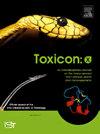Epidemiological and geodemographic patterns of scorpionism in Ecuador: A nationwide analysis (2021–2024)
IF 2.8
Q2 TOXICOLOGY
引用次数: 0
Abstract
Background
Approximately 1.2 million scorpion stings are reported globally each year, resulting in an estimated 3000 deaths. Of the 2500 known scorpion species, about 40 are considered medically significant. In Ecuador, where at least 47 scorpion species exist, information on scorpion stings remains scarce.
Methods
A nationwide cross-sectional analysis was conducted on all officially reported cases of scorpion stings documented in the epidemiological surveillance reports from the Ministry of Public Health in Ecuador between 2021 and 2024.
Results
A total of 1633 cases were identified, with women accounting for 52% of cases (n = 849). The highest incidence was observed among children aged one to four years old, with rates of 18.16 and 19.11 per 100,000 inhabitants for males and females, respectively. Geographically, the Amazon region was the most affected, with the province of Morona Santiago reporting the highest incidence at 284.14 cases per 100,000 inhabitants.
Conclusion
Scorpion stings represent a significant and underreported public health threat in Ecuador. This study highlights the considerable disease burden, particularly in specific regions of the country, and underscores the urgent need for targeted public health interventions and policy changes, including the local production of antivenoms.

厄瓜多尔蝎子病的流行病学和地理人口统计学模式:一项全国分析(2021-2024)
据报道,全球每年约有120万起蝎子蜇伤事件,导致约3000人死亡。在2500种已知的蝎子中,大约有40种被认为具有重要的医学意义。在厄瓜多尔,至少有47种蝎子存在,关于蝎子蜇伤的信息仍然很少。方法对2021 - 2024年厄瓜多尔卫生部流行病学监测报告中所有正式报告的蝎子蜇伤病例进行全国范围内的横断面分析。结果共检出1633例,其中女性849例,占52%。发病率最高的是1至4岁的儿童,男性和女性的发病率分别为每10万居民18.16和19.11。从地理上看,亚马逊地区受影响最严重,Morona Santiago省报告的发病率最高,为每10万居民284.14例。结论蝎子蜇伤是厄瓜多尔严重的公共卫生威胁,但未被充分报道。这项研究强调了相当大的疾病负担,特别是在该国的特定区域,并强调迫切需要有针对性的公共卫生干预措施和政策变革,包括在当地生产抗蛇毒血清。
本文章由计算机程序翻译,如有差异,请以英文原文为准。
求助全文
约1分钟内获得全文
求助全文
来源期刊

Toxicon: X
Pharmacology, Toxicology and Pharmaceutics-Toxicology
CiteScore
6.50
自引率
0.00%
发文量
33
审稿时长
14 weeks
 求助内容:
求助内容: 应助结果提醒方式:
应助结果提醒方式:


